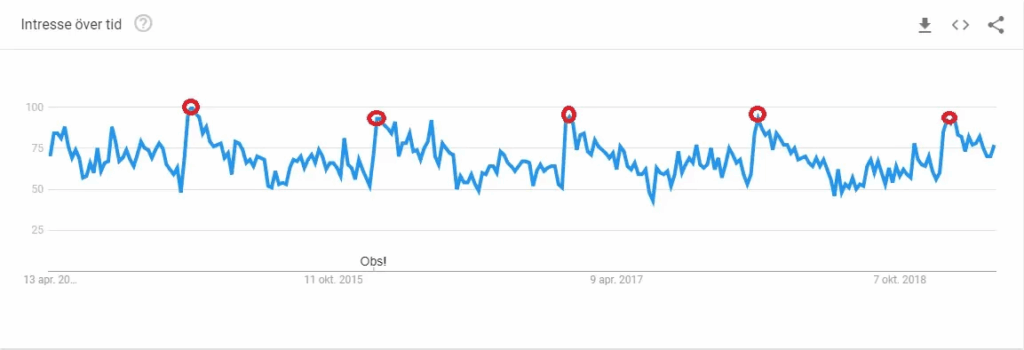
Accessing good and reliable data can be difficult and often very expensive to obtain. Traditionally, one has had to rely on customer data from surveys or data from social media, such as Facebook. However, these do not tell the whole story, only a small part of how current and potential customers think and feel.
Is there a cost-effective complement to gain further insight into how people think and search for solutions to their problems?
We claim that such a tool exists! It is free, underrated, and not used nearly as much by companies as it should be. The tool we want to highlight is called Google Trends.
What is Google Trends?
Google Trends is a tool that shows people’s search behavior and trends on Google. The tool was developed by Google itself and is intended to allow users to follow search trends worldwide, both in real time and historically. The Google Trends we see today is a combination of Google Trends and Google Insights, created with Google’s aim of collecting and organizing search data and trends in a comprehensible way for the public to access.
The data you can extract from Google Trends can be applied to a variety of use cases. A blogger can use the tool to get ideas for new blog posts, a journalist can see what people are interested in right now and write an article about it, and so on. However, we have chosen to focus on how the tool can be used from an SEO perspective.
Four ways to use Google Trends
Use Google Trends for keyword analysis
Google Trends can be used to generate new ideas for keyword research. With the help of the tool, you can see what is in demand right now, which searches are trending, and what people search for the most. You can also specify a time range to find out how people searched during a limited period. This is useful if, for example, you want to see what search trends looked like in the first week of October 2017.

In Google Trends, you can also get suggestions for related searches and phrases. These can be entered into the Keyword Planner to generate even more related keyword ideas. In this way, a large number of new keyword ideas can be created.
Explore new markets or prepare for trends abroad
Google Trends works not only globally but also locally. If you are considering expanding your business to a new market in another country, Google Trends can provide insight into the search behavior of that country. For example, for companies selling Swedish delicacies, it may be interesting to see if there are any trends for Swedish food in Germany.
Google Trends can also be used for trend spotting abroad, to predict trends before they arrive in Sweden. This way, you can discover new business opportunities within a trend long before it reaches the Swedish market. A useful tip is to look at countries that are often seen as trendsetters (such as the USA and the UK) to pick up on new trends before they break through here.
Busting myths about trends
Media outlets are often quick to write about various trends that are supposedly going to take us by storm. It doesn’t take much for a journalist to sound the alarm and announce the big fall trend before midsummer. With Google Trends, you can see whether there is actually increasing interest in the topic in question and whether it is being searched for on a large or small scale. Sometimes it’s reassuring to see that what tabloids call a “popular uprising” was really just a light breeze.
Knowing when to publish
Content is perishable and still king — meaning content is important — as everyone in digital marketing has heard countless times. What many don’t consider is that in some cases it can be a true perishable good, which, unlike wine or cheese, doesn’t necessarily get better with age.
Google Trends is therefore an excellent tool to determine what content should be created and when it should be published.
Say you run a gardening blog, in a segment that is not very competitive, and you’ve written an article about planting spring bulbs. You may see that people rarely search for “planting” during the winter months, but that in the last five years, searches start to increase from mid-February. It would then make sense to publish articles about “planting” already before Christmas so that those searching for the topic will find fresh content and discover your gardening blog.
Digging beneath the surface with Google
Working with search engine optimization often reveals a completely different side of the internet and its users. Accessing people’s searches is like peeking behind the curtains of social media. Someone who knows a lot about this is Seth Stephens-Davidowitz, who wrote the book: “Everybody Lies: Big Data, New Data, and What the Internet Can Tell Us About Who We Really Are.”
The book, as the title suggests, explores how Google can reveal things people are not willing to share on social media or in surveys. Stephens-Davidowitz argues that Google provides users with a strong sense of security, and therefore they share their darkest secrets with “therapist” Google.
In the book, the author reveals, among other things, that there was a spike in racist searches, as well as increased interest in the KKK and the website “Stormfront,” the day after Barack Obama was elected president. Even though search behavior doesn’t show the full picture, we believe it can serve as an interesting complement to traditional trend spotting and as another way to understand how Google users really think.
Some examples of how we search in Sweden
So what do searches look like here in Sweden? Like most countries, Swedes seem to engage in New Year’s resolutions, as searches for “exercise” skyrocket in search trends during January, only to drop as summer vacation approaches.
The red circles show when searches for “exercise” peak during the second week of January every year.

Quite simply, we present a different side of ourselves to Google than the image we may want to display on social media. Unfortunately, it is no longer possible to see exact search volumes unless you spend a certain amount of money in your Google Ads account. For the average person, however, it is possible to use Google’s autocomplete to see popular searches, although these suggestions come without search volumes.
When using Google’s autocomplete, we can present below what Google itself suggests when typing in “my boyfriend” and “my girlfriend.”


Married couples are not spared from negative searches either. When we type in a similar search for “my husband is” and “my wife is,” we find the following suggested results from Google.


This pattern of negative searches can also be observed when we look for queries related to people’s children. For example, searches like “my child hits me,” “my son/daughter has no friends,” or “my daughter cuts herself,” and so on. This is an image that never, or very rarely, appears in the flow of social media. However, we can take some comfort in the fact that searches for “Pörr” are moving strongly upward with about 210 searches per month, compared to the roughly 10 searches per month we had previously seen.
Google Trends – A Tool with Many Uses
As you can see above, Google Trends can be used in many different ways and can provide highly interesting data to complement your previous analysis of target groups and search behavior. Google Trends can make it clearer whether a trend is on the rise or if it is starting to decline.
In many cases, people don’t search for what business owners think they are searching for. People often have problems they didn’t even know they had, or embarrassing issues that make it easier to turn to a machine for finding a solution. When it comes down to it, the majority of users turn to Google to find a solution to a problem or a question they need answered. That is where you need to be — and be the solution to their question.
